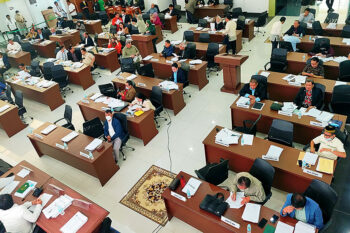DAVAO CITY (MindaNews/02 March) — The National Economic and Development Authority (NEDA) in Region 11 is expecting an eight percent economic growth this year on the back of projected strong performances by the industry, services and construction sectors, Maria Lourdes Lim, NEDA-11 director, said Friday.
In a media forum here, she expressed confidence of achieving a positive economic growth in the region despite the damages brought by super typhoon Pablo to agriculture and infrastructure facilities in the area last year.
Lim identified the services and industry sectors as the region’s likely main growth drivers for 2013.
“The services sector will continue to sustain the economy, particularly trade, transportation, storage and communication; business on information and communication technology (ICT); real estate and property development; and tourism sector-related services,” Lim said.
In 2012, the economic growth target for Region 11 was 6.8 percent. The NEDA regional office has yet to compile the data with the actual achievement expected to come out in June.
This year, Lim said they are expecting the regional economy to be also spurred by projects like the P3.5 billion steel manufacturing, a 186-room hotel worth P824.5 million and a low-cost mass housing worth P501 million in the area. These projects were committed through the Board of Investments.
There are other prospective investments for wholesale and retail trade such as shopping malls and electronics and steel manufacturing in the proposed economic zone in Sta. Cruz, Davao del Sur, according to NEDA-11.
There is also the expansion of business process outsourcing or BPOs and expansion of the ICT sector to knowledge process outsourcing such as health IT, bank office processes, engineering and design, it added.
Lim also said the public-private partnership or PPP ordinance in Davao City will open more opportunities for private sector participation in priority development projects in the city.
She said the emerging role of the city as a convention, investment, and tourism destination in the Southern Philippines is another opportunity for the region, citing that the city will host the National Advertising Congress and the Asia Pacific Economic Conference Ministers and Senior Officials in 2015.
Lim also pointed out the completion of the city’s Comprehensive Land Use Plan that will “provide spatial development directions to guide the business and private sector to achieve sustainable development.”
Reforms in the mining sector will also open opportunities this year for the Davao region, she said.
The Overseas Development Assistance projects for road improvements and landslide risk mitigation will be implemented this year, Lim said.
Lim also pointed out that government appropriations this year for the region amounted to P24.5 billion, with projects for the human development sector getting the bulk of P13.7 billion.
But in order to attain its growth target not just for 2013 but in forthcoming years, Lim said it is important that the impact of typhoon Pablo on agriculture, insufficient and unstable power supply in Mindanao, and the region’s increasing vulnerability to climate change must be addressed.
In an interview, Lim said that agricultural assistance has been extended to Pablo-hit areas such as providing seeds, credit assistance, and collateral loans through the Land Bank of the Philippines.
She admitted that due to the devastation wrought by Pablo, the agricultural growth “slightly” slowed down.
In order to raise the productivity level of the agricultural sector, Lim said there should be appropriate technologies as well as provision of more farm-to-market roads and pre- and post-harvest facilities especially to small farmers. (Lorie Ann A. Cascaro/MindaNews)






